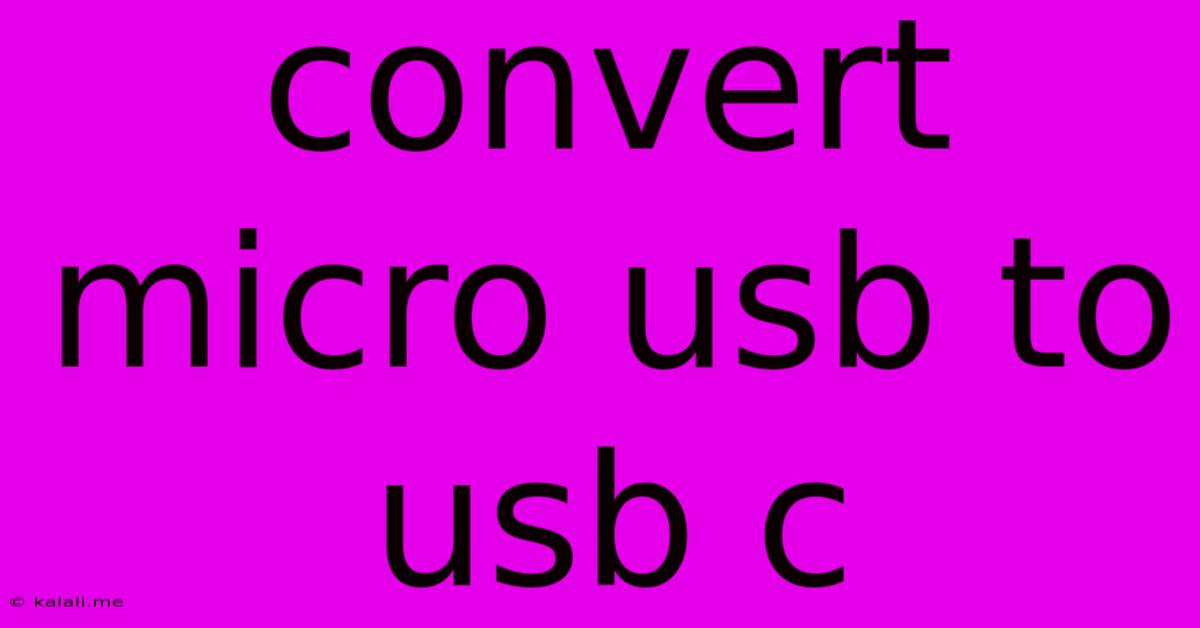Convert Micro Usb To Usb C
Kalali
May 22, 2025 · 3 min read

Table of Contents
Converting Micro USB to USB-C: A Comprehensive Guide
Meta Description: Need to adapt your older Micro USB devices to the newer USB-C standard? This guide explores the various ways to convert Micro USB to USB-C, outlining the pros and cons of each method. Learn about adapters, cables, and the important considerations for choosing the right solution.
The transition from Micro USB to USB-C has been significant in the tech world. While USB-C offers faster charging speeds and data transfer rates, many of us still have devices using the older Micro USB standard. This leaves many wondering: how do I convert Micro USB to USB-C? This guide will explore the different methods, helping you choose the best option for your specific needs.
Understanding the Differences: Micro USB vs. USB-C
Before diving into the conversion methods, it's helpful to understand the key differences between Micro USB and USB-C connectors. Micro USB, a smaller version of the standard USB-A connector, is rectangular and often used in older smartphones, tablets, and other devices. USB-C, on the other hand, is more symmetrical and oval-shaped, featuring improved power delivery and data transfer capabilities. This difference in design prevents direct connection without an intermediary solution.
Methods for Converting Micro USB to USB-C
There are primarily two ways to connect a Micro USB device to a USB-C port: using an adapter or a cable.
1. Using a Micro USB to USB-C Adapter
This is the most common method. A Micro USB to USB-C adapter is a small device that plugs into the USB-C port, providing a Micro USB female port for your older device. These adapters are inexpensive and readily available.
Pros:
- Cost-effective: Generally the cheapest option.
- Compact: Doesn't add much bulk.
- Widely available: Easily found online or in electronics stores.
Cons:
- Limited functionality: May not support high-speed data transfer or fast charging depending on the quality of the adapter. Check the specifications before purchasing.
- Potential for breakage: Frequent plugging and unplugging can weaken the connection over time.
- Compatibility issues: Some adapters might not be compatible with all devices due to power delivery limitations.
2. Using a Micro USB to USB-C Cable
This involves a cable with a Micro USB connector on one end and a USB-C connector on the other. This method eliminates the need for an adapter, offering a potentially more robust and reliable connection.
Pros:
- More durable: Generally more resilient to wear and tear than adapters.
- Potentially better performance: High-quality cables can support faster data transfer speeds and charging.
- Convenience: A single cable eliminates the need for separate adapters.
Cons:
- More expensive: Usually pricier than simple adapters.
- Bulkier: Can be more inconvenient to carry around compared to a compact adapter.
- Compatibility is still key: Ensure the cable supports the desired data transfer and charging speeds.
Choosing the Right Solution
The best method depends on your individual needs and priorities. If you're on a budget and only need to occasionally connect a device, a Micro USB to USB-C adapter is a practical choice. However, for frequent use and optimal performance, a Micro USB to USB-C cable might be a better investment. Always check the specifications of the adapter or cable to ensure compatibility with your devices and desired data transfer and charging speeds.
Important Considerations
- Data Transfer Speeds: Not all adapters and cables support the same data transfer speeds. If you need high-speed data transfer (e.g., for transferring large files), choose a high-quality adapter or cable that explicitly supports this.
- Power Delivery: The same principle applies to charging. Fast charging requires an adapter or cable that supports the necessary power delivery capabilities.
- Brand Reputation: Choose reputable brands known for their quality products to avoid potential compatibility or performance issues.
By understanding the differences between adapters and cables, and considering the factors outlined above, you can confidently choose the best method to convert Micro USB to USB-C for your devices. Remember to always prioritize quality to ensure optimal performance and longevity.
Latest Posts
Latest Posts
-
Princess Mononoke Spirit Of The Forest
May 22, 2025
-
Does Full Stop Go Inside Brackets
May 22, 2025
-
Can I Take Empty Water Bottle Through Airport Security
May 22, 2025
-
What Does A Blue Sign With A Red Cross Mean
May 22, 2025
-
What Does Psa Stand For In Text
May 22, 2025
Related Post
Thank you for visiting our website which covers about Convert Micro Usb To Usb C . We hope the information provided has been useful to you. Feel free to contact us if you have any questions or need further assistance. See you next time and don't miss to bookmark.